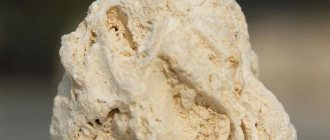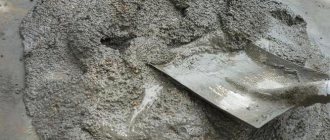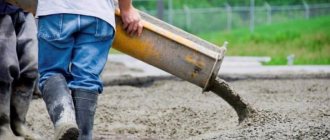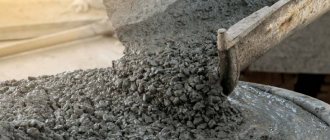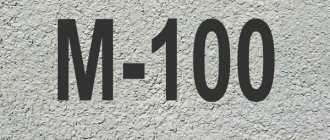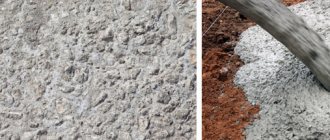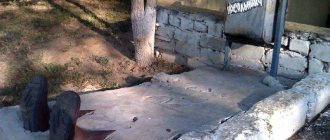New materials are constantly appearing on the construction market, but traditional solutions do not lose their popularity and continue to be used to solve various problems. These include heavy concrete, which is used in a wide variety of cases. On their basis, floor slabs, trusses, lintels, reinforced belts, huge blocks and other structures are created.
Advantages and disadvantages
Understanding the question of what heavy concrete is, you need to familiarize yourself with the advantages of its use.
These include:
- Easy to serve and install.
- Long service life.
- Increased strength properties after drying.
- Affordable price.
- High density.
- Compliance with fire safety requirements.
Positive qualities include resistance to moisture and negative temperatures.
The list of minuses includes the following items:
- The need to install additional thermal insulation coating.
- The need for regular wetting with water to obtain optimal strength properties.
- The need for finishing work.
- A number of difficulties in organizing communications.
Frost resistance
When choosing concrete, be sure to take into account the climatic conditions in which the structure will be used. For the middle and northern zones - this is frost resistance (F). It is regulated by plasticizers:
- Low frost resistance less than F50;
- Average frost resistance (F50...F300);
- High frost resistance (F300 and more).
Areas of application
The specific properties of heavy concrete make it possible to use it to solve large construction problems, including:
- Arrangement of reinforced concrete structures. To increase strength properties and reduce hardening time, special mineral fillers are introduced into the composition and subjected to heat treatment.
- Construction of hydraulic structures. This area requires special attention and responsibility, so high demands are placed on the class of material. To equip an industrial facility with an increased degree of stability, especially hard concrete is used. It is characterized by a long service life and resistance to external factors.
- Coating of highways and airport roads. Heavy concrete, the density of which is quite high, can withstand heavy loads from massive equipment, and its resistance to negative temperatures contributes to the construction of a reliable and durable coating.
- Pouring foundations for industrial facilities. Due to its improved strength properties, the material can be used to construct foundations for large buildings.
- Laying walls and ceilings of premises that have high requirements in terms of reliability. These include bank vaults, government facilities, chemical plants and factories.
Heavy-duty concrete is required for all structures that face heavy loads. Due to its special properties and characteristics, its popularity remains high, despite the emergence of new materials and solutions.
Types of concrete
Heavy concrete, the composition of which is based on higher grades of Portland cement, can be intended for different purposes.
Depending on the scope of application, there is the following classification of material:
- Highly durable. During the mixing process, the best cement mixture, clean sand and coarse crushed stone are added. Production is carried out using vibration equipment, which gives the concrete the increased density of heavy concrete. In order to increase strength, additional components - plasticizers - are added to the composition.
- Reinforced concrete. Used for the construction of reinforced concrete blocks, floors and other reinforced concrete structures.
- Fast setting. It contains a quick-hardening cement mixture and additional elements, including hydrogen chloride. The presence of additives helps reduce the hardening time without losing the quality of the final product.
- For hydraulic structures. It is a special type of concrete that is used for the construction of structures in damp environments. The material is not affected by water, and it retains its original appearance even after several years of intensive use.
- Road. It is used to cover highways and is resistant to heavy technical loads.
- Cast. It is created on the basis of fast-hardening cement with plasticizers and a high liquid content in the composition.
- Fine grained. It is created on the basis of cement stones without the presence of large and heavy components. It is in demand when constructing buildings with thin walls.
- Acid resistant. It is resistant to aggressive substances and acids, therefore it is used for the construction of chemical-type premises.
- Heat resistant. Not afraid of prolonged exposure to high temperature environments. Industrial furnaces operating at temperatures up to 12000°C are built on the basis of heat-resistant concrete.
- Polymer varieties. During the production process, raw materials are impregnated with special resins and polymer additives. This provides an increased degree of strength and reliability.
- Decorative. It is produced using dyes and special fillers, such as natural-colored marble stone. The material is in demand for the construction of alleys and parks, decorating garden paths and borders, designing facades, etc.
There are also special types of concrete, which differ in different composition and class.
Curing conditions
Concrete with different compositions require certain hardening conditions:
- Natural conditions (temperature 20-22°C, humidity about 50-70%);
- Heat treatment at normal pressure is necessary, for example, during winter construction, when maintaining a positive temperature is required;
- Heat treatment at high pressure (autoclave). This is how individual structures for construction are created.
Classification of types of concrete helps to make the right choice of material, taking into account all the key qualities of the material. We recommend purchasing material with the selected characteristics from specialized manufacturers who provide documentation confirming the quality. Only in this case will all the conditions and subtleties of the formulation be met, which means that the material will have the qualities specified in the calculations.
- Wall kit
- Foundation
Characteristics
The properties of heavy concrete directly depend on the raw materials used in the process of mixing the mixture and the scope of application of the material.
Modern classification is based on the following characteristics:
- By class.
- By concrete grade.
- According to GOST.
- By cost.
By class
Existing classes of concrete differ in both performance characteristics and quality. According to GOST standards, a whole line of materials with different grades is distinguished. It includes solutions such as B3.5, B5, B7.5, B10, B12.5, B25, B30, B70, B90, B100, etc. GOST standards also allow the production of intermediate classes, such as 27.5.
The listed varieties are characterized by special properties that need to be paid attention to when choosing or creating a concrete solution. The main characteristics are specified in the standard.
Concrete grades
Brand identification is determined by compressive strength and axial tensile strength. Depending on these properties, the following brands are distinguished:
- M50 and M100 are characterized by low compressive strength, which does not allow them to be used for a wide range of construction works. The main area of application is landscaping.
- M150 - the brand is in demand in the production of screeds and blind areas.
- M200 is considered the most popular material for the restoration of foundations, platforms and stairs.
- M250 and M350 are used for the construction of monolithic buildings and other concrete structures.
- M350 demonstrates an increased degree of strength and is used in the manufacture of airfield slabs.
- M400 is used to create secure bank vaults, hydraulic structures and bridges.
- M500-M600 are used in the construction of the subway.
There are also particularly strong compounds with grades up to M800, but their use is quite rare.
GOST
Each composition of heavy concrete must meet certain GOST requirements. Any deviations from the given rules are unacceptable. When producing this building material, you need to take into account the GOST 26633-2012 standard, which provides for the following values:
- Frost resistance - F500.
- Water resistance - W6-W12.
- Shrinkage during setting is 0.15 mm per 1 m.
- Tensile strength - Bt10-Bt40.
Price
The cost of the solution is determined by a number of factors, including the price of all components. While water, crushed stone and clean sand are quite easy to find, purchasing plasticizers and other additives will require some effort and financial investment. The price tag also depends on the brand of the mixture. Production of 1 m³ of solution under the M100 brand will cost 2,400 rubles.
The use of super-heavy concrete in private construction is not justified, which is due to the high cost of all components. The solution provides for the presence of rare elements.
Slags and ash as fillers, as well as marl
The process of preparing concrete mortar can be based on replacing small and large aggregates with more affordable ash and slag mixtures, slags or ash. The technical conditions for the production of these materials are regulated by GOST 57789-2017 , which came into force on January 3, 2022. This makes it possible to mix cement mortars of higher grades, for example, M450 and M500, increase the water resistance and frost resistance of concrete, and save from 10 to 25% of cement.
The use of ash and slag mixtures is more profitable than replacing crushed stone with marl , since the created solution loses strength. Marl is most often used as a material for the construction of load-bearing walls, the strength of which depends on their thickness, which is more than 0.5 m. It is also beneficial to use marl as a replacement for crushed stone in those areas where it is mined, but we repeat, the strength of such concrete is lower and the maximum the strength of concrete that can be obtained with such a filler is M200-M250. Slags and ash make it possible to prepare light and heavy concrete of high quality and at the same time save resources.
Basic properties
The main properties of concrete include:
- Strength.
- Water resistance.
- Porosity.
- Frost resistance.
- Thermal conductivity.
- Fire resistance.
Strength
A key indicator of high quality concrete is its strength. Heavy varieties must cope with intense loads, so high demands are placed on strength properties.
They must be observed both at the stage of mixing the mixture and when solving all construction problems. Since concrete is considered a non-uniform material, fluctuations in strength are considered normal.
Water resistance
Concrete is considered a waterproof material that does not lose its initial characteristics after prolonged exposure to a humid environment. Water resistance indicators depend on the ratio of components in the composition and are depicted under the letter W. The value range varies from W2 to W20.
Porosity
Even the most durable brands of concrete have small cells, which determine a property such as porosity. The intensity of porosity is determined by the type and volume of filler, as well as the ratio of water and cement. The degree of vibration treatment and a host of other factors are also taken into account. The base value varies from 6 to 15%.
Frost resistance
The degree of frost resistance indicates the material’s resistance to the destructive effects of negative temperatures or loads when moisture thaws after a long winter. Frost resistance refers to the number of freezing and defrosting cycles. The more such cycles, the higher the indicator. Commercially available brands have values from 50 to 300 cycles.
Thermal conductivity
The weak point of concrete is its thermal conductivity. Despite the improved strength properties and long service life, the material is subject to severe freezing and cannot retain heat inside itself. As density increases, thermal conductivity increases.
Fire resistance
Fire resistance is considered the most important property of a material, which determines its resistance to ignition. When exposed to temperatures up to 200ºС, strength characteristics are reduced by 30%. When the temperature rises to 500ºС, the structure deforms.
Calculation of composition and batching
When making calculations for the future mixture, it is necessary to adhere to the recommended values and requirements, since they determine the strength and reliability of the structure. Experts offer ready-made proportions that allow you to correctly calculate the ratio of all components:
| Concrete grade | Quantity of concrete from 10 liters of cement (l) | Composition of volume per 10 l (P/Sh) | Total mass composition (C/P/Shch) (kg) |
| 450 | 29 | 10/22 | 1/1, 1/2,5 |
| 400 | 31 | 11/24 | 1/1,2/2,7 |
| 300 | 41 | 17/32 | 1/1,9/3,7 |
| 350 | 43 | 19/34 | ½,1/3,9 |
| 200 | 54 | 25/42 | ½,8/4,8 |
| 150 | 64 | 32/50 | 1/3,5/5,7 |
| 100 | 78 | 41/60 | ¼,6/7 |
When kneading with your own hands, you must follow the following instructions:
- We prepare a container where the mixture will be mixed.
- We place water in the container (in the case of other types of concrete, filler is initially placed).
- We add cement, sand and filler to the composition, continuing to mix the solution.
- Next we add additional components and plasticizers, if necessary.
- The solution is mixed until a homogeneous consistency free of lumps is obtained.
By following this guide, you can make a high-quality concrete solution that will meet all requirements and standards.

